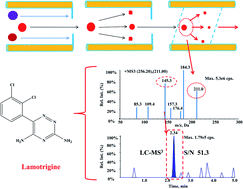A LC-MS3 strategy to determine lamotrigine by Q-Q-trap tandem mass spectrometry coupled with triple stage fragmentation to enhance sensitivity and selectivity†
Abstract
A high-performance liquid chromatography tandem mass spectrometry cubed (HPLC/MS3) method was developed and validated to quantify lamotrigine in human plasma with carbamazepine as an internal standard. The HPLC/MS/MS system is composed of a Shimadzu UFLC XR high-performance liquid chromatograph coupled with a hybrid linear ion trap triple quadrupole mass spectrometer. Following simple protein precipitation with methanol, the separation of lamotrigine and carbamazepine was performed on an Agilent Poroshell 120 SB-C18 column (4.6 × 50 mm, 2.7 μm) using gradient elution with 0.1% formic acid in water (solvent I) and 0.1% formic acid in methanol (solvent II) at a flow rate of 0.8 mL min−1. The total run time for each sample was 5 min. The method was validated for accuracy, precision, linearity, lower limit of quantification (LLOQ), selectivity, and other parameters. The LC/MS3 method was linear in the concentration range of 0.50–50.0 μg mL−1 (R2 ≥ 0.995). The LLOQ was 0.5 μg mL−1, requiring only 30 μL of human plasma. Intra- and inter-day accuracies were <6.17% and precisions were <11.4% at all concentrations. The absolute recoveries (%) and matrix effect (%) for lamotrigine in human plasma were between 83.8 and 90.7. The developed and validated LC-MS3 assay was successfully applied to monitor the lamotrigine levels in human plasma after the administration of lamotrigine.



 Please wait while we load your content...
Please wait while we load your content...